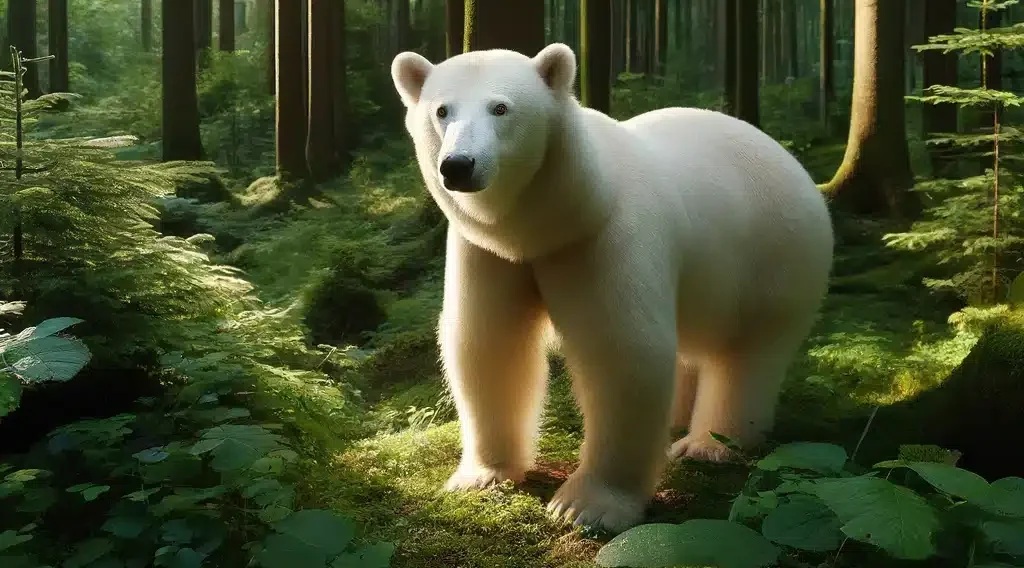Imagine a massive bear, its fur shimmering an ethereal white against the backdrop of a lush green forest. This isn’t a scene from a fantasy novel; it’s the awe-inspiring reality of the albino bear, a creature of myth and legend come to life.

Throughout history, albino animals have captivated our imaginations. Their lack of pigmentation creates a striking appearance, setting them apart from their brethren.
Among these rarities, the albino bear stands out as a symbol of untamed wilderness and breathtaking beauty. But beyond their captivating looks lies a fascinating story of genetics, adaptation, and the delicate balance of nature.
Let’s delve into the world of the albino bear, exploring the science behind their unique appearance, the challenges they face, and how we can appreciate these magnificent creatures responsibly.
What is Albinism and How Does it Affect Bears?
Albinism is a genetic condition that affects the production of melanin, the pigment responsible for skin, hair, and eye color. In albino bears, a malfunction in melanin production results in a complete or partial absence of pigment, leading to their characteristic white or cream fur. This condition can manifest in two main forms:
- Oculocutaneous Albinism (OCA): This is the most common form affecting skin and eyes. Albino bears with OCA will have white fur, pink noses and paw pads, and light-colored eyes that may appear pinkish or reddish due to underlying blood vessels.
- Ocular Albinism: This rarer form primarily affects the eyes, with fur pigmentation remaining relatively normal. Albino bears with ocular albinism may have brown or black fur but exhibit light-colored eyes with vision problems.
A Life of Challenges: The Struggles of Albino Bears

While their white fur might seem majestic, it presents a significant challenge for albino bears in the wild. Here’s why:
Camouflage Complications: A bear’s dark fur acts as natural camouflage, allowing them to blend into their surroundings while hunting prey or avoiding predators. Albino bears, lacking this camouflage, struggle to stalk prey effectively and become more vulnerable to attacks themselves.
Vision Issues: Some albino bears, particularly those with Oculocutaneous Albinism, may have poorer eyesight due to reduced light sensitivity in their light-colored eyes. This can make it difficult for them to navigate their environment, hunt efficiently, and avoid potential dangers.
Social Exclusion: Within bear societies, fur color plays a role in communication and social interactions. Albino bears may face some degree of social exclusion from their groups due to their distinct appearance.
However, despite these challenges, albino bears exhibit remarkable resilience. They adapt their hunting strategies, rely more on their sense of smell and hearing, and sometimes even compensate for vision problems by hunting during lower light conditions like dusk or dawn.
Beyond Beauty: Responsible Observation
The captivating sight of an albino bear draws a natural desire to witness them firsthand. However, it’s crucial to remember that these are wild animals, and ethical observation is paramount. Here’s how you can appreciate albino bears responsibly:
Respect Their Habitat: Avoid venturing off designated trails or disturbing natural areas in search of albino bears. This minimizes disruption to their environment and ensures your safety.
Maintain a Safe Distance: Use binoculars or a telephoto lens for a closer look. Never approach an albino bear, as even seemingly calm behavior can be unpredictable.
Minimize Disruptions: Avoid loud noises or sudden movements that could startle the bear. Be patient and allow them to go about their natural activities undisturbed.
Leave No Trace: Pack out all trash and avoid leaving any foreign objects behind. Responsible observation ensures the pristine wilderness remains a safe haven for these rare creatures.
By following these guidelines, you can contribute to the well-being of albino bears and ensure their continued existence for future generations to admire. Remember, responsible observation allows us to appreciate these magnificent creatures while respecting their wild nature.
The Future of the Ghostly Bear: Conservation Efforts

Albino bears are a testament to the incredible diversity of the natural world. Yet, their rarity highlights the importance of conservation efforts. Habitat loss, poaching, and climate change pose significant threats to bear populations overall, and albino bears, with their already unique challenges, maybe even more vulnerable.
Here’s how you can contribute to a brighter future for albino bears and their brethren:
Support Conservation Organizations: Several organizations are dedicated to bear research and conservation. Consider donating or volunteering with reputable groups that work to protect bear habitats and address threats to their populations.
Educate Yourself and Others: It is crucial to spread awareness about the importance of bear conservation and ethical wildlife observation. Sharing information about albino bears and their challenges can inspire others to appreciate and protect them.
Make Sustainable Choices: Our everyday choices can impact the environment. Opting for sustainable products and practices that minimize ecological footprints can contribute to a healthier planet for all wildlife, including bears.
By taking action and supporting conservation efforts, we can ensure that the “ghost of the forest” continues to roam free, a symbol of resilience and the enduring beauty of the wild.
Conclusion: Coexisting with the Albino Bear
The albino bear stands as a captivating reminder of nature’s wonders and the delicate balance within ecosystems. Their rarity and challenges inspire awe, while their resilience teaches us about adaptation and survival. But our appreciation shouldn’t stop at admiration.
By committing to responsible observation and supporting conservation efforts, we can ensure the continued existence of these magnificent creatures. Let’s move beyond simply marveling at the “ghost of the forest” and take action to ensure their future remains as bright as their unique fur.
The next time you explore the wilderness, remember the albino bear – a symbol of the beauty and vulnerability of nature, and a call to become a responsible steward of our wild spaces.
Albino Bear FAQ

Are albino bears dangerous?
Albino bears are wild animals and should be treated with caution. However, they are not inherently more aggressive than their normally pigmented counterparts. It is crucial to maintain a safe distance and avoid any actions that might startle them.
Can albino bears survive in the wild?
Albino bears face challenges due to their lack of camouflage and potential vision issues. However, they exhibit remarkable resilience, have adapted hunting strategies, and rely more on other senses to navigate their environment.
Where can I see an albino bear?
Albino bears are rare, and sightings are uncommon. However, some regions with established bear populations, particularly black and grizzly bears, may have a higher chance of spotting an albino individual. It’s important to prioritize ethical wildlife observation by respecting designated areas and maintaining a safe distance.
Is it legal to hunt albino bears?
Hunting albino bears is legal depending on location and specific wildlife regulations. It’s crucial to check with your local wildlife authorities for up-to-date hunting regulations and any restrictions regarding albino animals. This blog focuses on appreciating albino bears and promotes responsible observation, not hunting.
What can I do to help albino bears?
Here are some ways you can contribute to the well-being of albino bears and all bear populations:
- Support reputable wildlife conservation organizations.
- Educate yourself and others about the importance of bear conservation and responsible wildlife observation.
- Make sustainable choices that minimize your ecological footprint.
- Advocate for policies that protect bear habitats and address threats to their populations.





Very great info can be found on blog.Raise your business